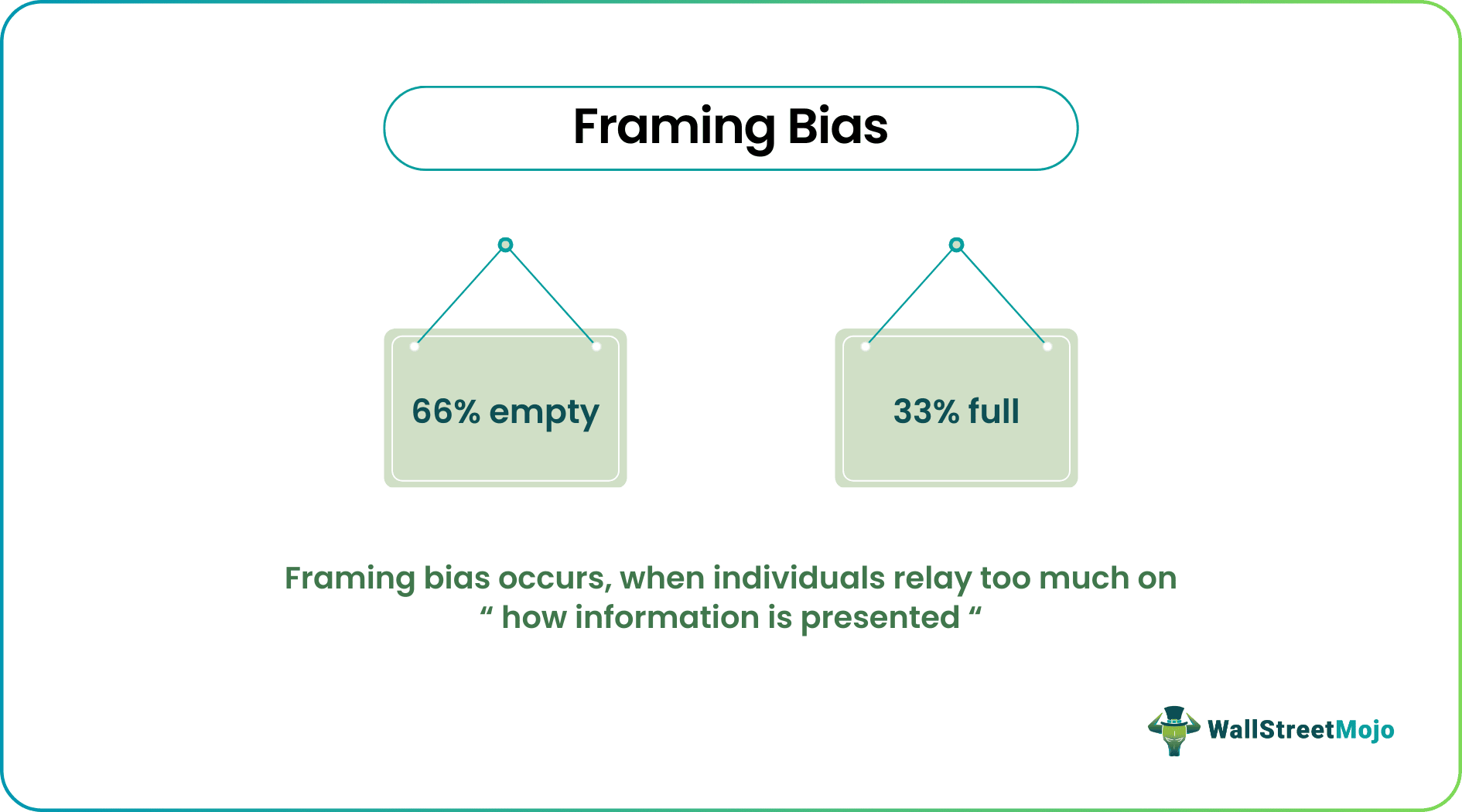Table Of Contents
Framing Bias Definition
Framing bias occurs when people decide based on how information is presented. Due to this cognitive bias, individuals overlook factual data. The bias is either influenced or caused by reflexive decision-making.
When the same piece of information is presented in different ways, the response varies. In financial decision-making, this bias can cause serious consequences. It is apparent when an investment is pitched to investors or when a product is introduced to buyers.
Key Takeaways
- Framing bias is a perceptive error; it occurs when people rely too much on how information is conveyed. As a result, decision-makers often ignore factual evidence.
- Sentences can be framed positively or negatively—often, individuals respond to the tone and style of presentation. This perception influences their decisions.
- In financial decision-making, this bias can be challenged by thinking rationally. Before making a choice, investors must evaluate the options based on factual data.
Framing Bias Explained
Framing bias is categorized under cognitive biases. It is also called framing effect bias. When an individual’s decisions are dominated by the way information is presented, it is referred to as a framing bias. Instead of relying on facts and figures, these individuals get persuaded by the framing of sentences.

For example, if an investment product is presented optimistically, a positive response from investors is more likely. If the same product is presented pessimistically, investors might develop a negative perception.
Let us assume that a bond can be presented in the following two ways:
- The bond offers a 10% fixed return every annum.
- The investor's money will double in 10 years.
Both the sentences have the same context, but they are framed differently. If an investor is looking for an investment that provides stable returns, they may favor the first sentence, i.e., the fixed return of 10%.
The same investor may refuse if the advisor pitches the second sentence, i.e., doubling the money in 10 years. In this scenario, the presentation of the fact matters because investors may not be interested in long-term investment.
Video Explanation of Framing Bias
Framing Bias Examples
Let us look at some examples to better understand cognitive predispositions.
Example #1
Just when an IPO is about to release, an investor wants to buy a $200 stock. The promoter can pitch the issue in the following two ways:
- There is a 70% chance of success, and the shares are expected to go up by 45% on the first trading day.
- There is only a 30% chance of failure, but if the IPO succeeds, then the stock price may scale up by almost 45%.
Both pitchers convey the exact same meaning. But the first statement is framed optimistically, and the second one is framed pessimistically. The first pitch will result in a successful promotion, whereas the second pitch will fail—it will not persuade the investors.
Example #2
Retirement plan pitches like the 401(k) are good examples of framing bias. Initially, companies offered two options to their employees:
1. Invest in the 401(k) plan
2. Do not invest in the 401(k) plan.
It was an active election approach. But many employees willingly declined retirement plans.
Later, the presentation was amended, keeping framing bias in mind. Employees were told, "you will participate in retirement plan unless you choose not to.” The new automatic enrolment process paid off—the retirement-plan participation rate jumped from 37% to 86%.
How to Overcome Framing Bias?
This flaw in cognition can cause huge financial losses. By not thinking rationally, investors can miss a better investment opportunity. Alternatively, framing bias can lead to investing in the wrong fund.
The following measures can help investors avoid framing bias:
- Be Analytical in Decision Making: Investors should research their investment plans thoroughly—should not rely too much on presentation. Investors must endeavor an independent analysis of presented facts and figures.
- Have a Heuristic Approach: Investors should always ask questions about the proposed investment—should decide only when they are satisfied with the answers.
- Don't Take Shortcuts: Avoid get-rich-quick schemes. Beware of schemes that promise high returns in a short period. Investors should be calculative; before investing, they must determine the product’s internal rate of return, price to earnings ratio, and debt to equity ratio.
- Have a Long-Term Perspective: Investors should focus on long-term wealth maximization.
Frequently Asked Questions (FAQs)
The presentation can impact people's mindset and decision-making both positively and negatively. Usually, people focus more on how information is conveyed rather than the actual data itself.
Let us consider two insurance agents who promote an insurance scheme. The agents had different pitches:
1st Agent: Our company settles almost 75% of its claims.
2nd Agent: Our company refuses only 25% of its claims.
Both agents convey the same underlying fact. Yet, the first agent frames a positive statement, and the second agent approaches with a negative figure. Due to customers’ framing bias, the first agent acquires more clients.
For wealth maximization, investors must focus more on facts and long-term possibilities. Investors must think rationally before making a decision.

